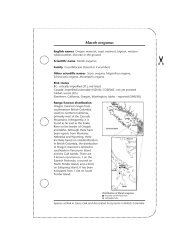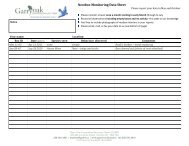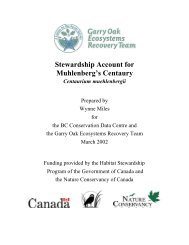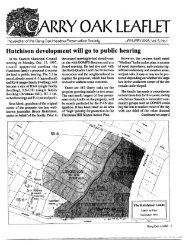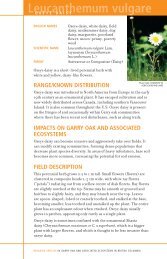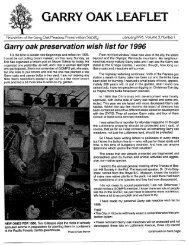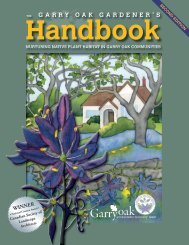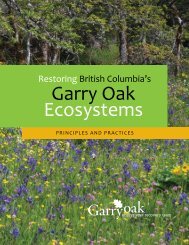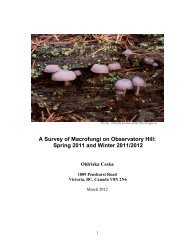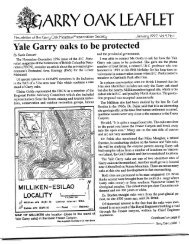PDF 691KB - Garry Oak Ecosystems Recovery Team
PDF 691KB - Garry Oak Ecosystems Recovery Team
PDF 691KB - Garry Oak Ecosystems Recovery Team
You also want an ePaper? Increase the reach of your titles
YUMPU automatically turns print PDFs into web optimized ePapers that Google loves.
Senecio jacobaea & vulgaris<br />
TANSY RAGWORT & COMMON GROUNDSEL<br />
ENGLISH NAMES<br />
SCIENTIFIC NAME<br />
FAMILY<br />
Tansy ragwort 1 or stinking<br />
willie 1 and common groundsel 2<br />
or old-man-in-the-spring 2<br />
Senecio jacobaea 1 and Senecio<br />
vulgaris 2<br />
Asteraceae<br />
Tansy ragwort and common groundsel are weeds<br />
of agricultural and disturbed areas and have yellow<br />
flowerheads and distinctive ruffled-looking leaves.<br />
Photo Credit: © DAVE POLSTER<br />
#<br />
RANGE/KNOWN DISTRIBUTION<br />
Tansy ragwort and common groundsel are native to Europe and western<br />
Asia and have spread around the globe since the 19th century. Tansy ragwort<br />
was likely first introduced to North America for its use as a medicinal herb<br />
and has since spread via contaminated hay. These species are now found in<br />
Canada and the United States, as well as Argentina, New Zealand, Australia,<br />
and South Africa (tansy ragwort), and Greenland (common groundsel).<br />
The Canadian range of these species includes eastern Canada and British<br />
Columbia, as well as Alberta and Manitoba for common groundsel. In<br />
BC, tansy ragwort is found in the Fraser and Okanagan Valleys, Vancouver<br />
Island, the Gulf Islands, and Haida Gwaii, while common groundsel is<br />
found throughout the province, but primarily on Vancouver Island, the Gulf<br />
Islands, Haida Gwaii, and the Lower Mainland.<br />
IMPACTS ON GARRY OAK AND ASSOCIATED<br />
ECOSYSTEMS<br />
Tansy ragwort and common groundsel invade woodlands and forests that<br />
have been disturbed and out-compete native species, hindering their<br />
colonization and decreasing biodiversity. They are agricultural pests (tansy<br />
ragwort is considered a noxious weed in BC) and can spread quickly and<br />
reduce forage production by up to 50%. They also contain alkaloids that<br />
are toxic when ingested by livestock; the alkaloids cause irreversible liver<br />
damage that can kill cattle and horses, as well as taint milk and honey. Tansy<br />
ragwort has been found to release chemicals toxic to other plants, increasing<br />
its competitive advantage. Bare patches remaining when the plant dies off in<br />
summer are susceptible to further invasion by this and other alien invasive<br />
species. Soil microbe diversity is reduced in areas infested by tansy ragwort.<br />
FIELD DESCRIPTION<br />
Both species have a fibrous taproot. Tansy ragwort and biennial common<br />
groundsel spend their first year as a rosette. Basal leaves are dark green with<br />
a whitish and finely hairy underside in tansy ragwort and purplish underside<br />
invasive species in garry oak and associated ecosystems in british columbia
SENECIO JACOBAEA & VULGARIS<br />
Flowerhead<br />
bracts blacktipped<br />
Both disc and<br />
ray flowers,<br />
10-15 ray<br />
flowers, 4-10<br />
mm long<br />
Leaves larger<br />
than in common<br />
groundsel,<br />
4-20 cm x 2-6 cm,<br />
reduced up stem<br />
Vascular Plants of the Pacific Northwest, Leo C. Hitchcock;<br />
Arthur Cronquist, and Mario Ownbey, illustrations by Jeanne R.<br />
Janish. Published by the University of Washington Press (1969).<br />
Disc flowers only,<br />
flower heads 5-8<br />
mm tall x 4-5 mm<br />
wide, cylindrical<br />
Stem leaves<br />
larger than<br />
basal leaves,<br />
2-10 cm x 0.5-<br />
4.5 cm. Basal<br />
leaves stalked,<br />
0.8-3 cm x<br />
0.3-1 cm.<br />
Seeds of disc<br />
flowers topped<br />
with a pappus of<br />
white silky hairs to<br />
5 mm<br />
#<br />
in common groundsel. In subsequent years, one to a few flowering stems<br />
develop that can be purplish, hairy and are erect and branched near the<br />
top. Stems grow up to 1.2 and 0.6 m tall, respectively, in tansy ragwort<br />
and common groundsel. The stem leaves are larger than the basal leaves<br />
and are unstalked (sometimes clasping at the base in common groundsel)<br />
or short-stalked. Basal and stem leaves are deeply lobed with toothed<br />
margins, appearing ruffled; these are smaller in common groundsel. In<br />
tansy ragwort, yellow flowerheads up to 2.5 cm across consist of 10-15<br />
petal-like ray (outer) flowers and disc (inner) flowers. Common groundsel<br />
flowerheads are also yellow but lack ray flowers and are cylindrical. The<br />
outer bracts of flowerheads are black-tipped. Flowerheads tend to cluster<br />
together at the same height. Seeds of ray flowers (tansy ragwort) are<br />
hairless, while the seeds of the disc flowers are tipped with a silky white tuft<br />
of hairs.<br />
LIFE HISTORY<br />
Tansy ragwort is a biennial or short-lived perennial herb. Reproduction is<br />
primarily by seed, although it can also occur vegetatively by sprouting root<br />
fragments in damaged plants. Germination usually occurs in the fall or<br />
spring but can occur year round. Tansy ragwort then spends the first year<br />
as a basal rosette. Flowering stalks are produced in subsequent years with<br />
flowering usually occurring July through September. Common groundsel<br />
is an annual that can complete its lifecycle in 5-6 weeks; it is sometimes<br />
biennial. Flowering can occur year-round, producing more than one<br />
generation per year. Both species produce seeds prolifically with a single<br />
large tansy ragwort plant producing up to 150,000 seeds. Seeds are wind-<br />
invasive species in garry oak and associated ecosystems in british columbia
SENECIO JACOBAEA & VULGARIS<br />
dispersed to within a few metres of the parent plant or are dispersed<br />
via water, people and wildlife. Plants are self-fertilized.<br />
HABITAT<br />
Tansy ragwort and common groundsel occur primarily on disturbed lands<br />
including agricultural fields, clear cuts, roadsides, trails and waste areas.<br />
Tansy ragwort has also been known to invade woodlands and open meadows.<br />
It prefers full sun to partial shade and well-drained, dry to moist soil<br />
conditions; it is not greatly affected by soil acidity or texture. Common<br />
groundsel is shade-intolerant and prefers open sites having very moist to<br />
wet, nitrogen-rich soils.<br />
#<br />
MANAGEMENT<br />
The control of tansy ragwort and common groundsel requires an integrated<br />
management approach using a combination of the following methods. It is<br />
important to act immediately to control new infestations and to prevent the<br />
plants from setting seed.<br />
Develop a long-term, realistic program for invasive species<br />
removal before undertaking any work. Before taking action,<br />
obtain expert advice. Please refer to the introductory section<br />
of this manual.<br />
PHYSICAL CONTROL: Hand pulling prior to seed set is the most common<br />
method of control. However, this is only feasible for small infestations and<br />
all the roots must be removed to avoid regrowth. This is best accomplished<br />
when soils are moist, aiding removal of the roots. If the plant has already<br />
begun to flower, flower heads should be carefully bagged and burned or<br />
disposed of as they are still capable of producing seeds.<br />
BIOLOGICAL CONTROL: Biological control agents have been successful at<br />
reducing the severity of tansy ragwort infestations. Several agents have been<br />
released including the cinnabar moth (Tyria jacobaeae), tansy ragwort seed fly<br />
(Pegohylemyia seneciella) and tansy ragwort flea beetle (Longitarsus jacobaea).<br />
The cinnabar moth also attacks common groundsel, but is not effective on<br />
its own. The rust fungus Puccinia lagenophora can control common groundsel<br />
depending on the timing of infection; plants infected in the summer were<br />
more likely to die than those infected in the fall.<br />
CHEMICAL CONTROL: The application of herbicides has resulted in a 95%<br />
reduction in the number of flowering stems of tansy ragwort the following<br />
year. Effective herbicides include dicamba, 2, 4-D, glyphosate and picloram.<br />
Chemicals should be spot sprayed to avoid damage to non-target vegetation<br />
invasive species in garry oak and associated ecosystems in british columbia
SENECIO JACOBAEA & VULGARIS<br />
and are most effective when applied to basal rosettes, particularly during<br />
the growth phases in early spring or mid-fall. Common groundsel has<br />
developed a resistance to triazine herbicides including atrazine and<br />
simazine. Herbicides should only be used with extreme caution, and under<br />
expert advice, in sensitive <strong>Garry</strong> oak ecosystems.<br />
OTHER TECHNIQUES: Mowing or grazing prior to flowering can be<br />
effective at reducing seed production in areas where this would not cause<br />
damage to desirable native species. These practices are only temporary<br />
solutions and can stimulate regrowth. Sheep are immune to the toxic<br />
effects of the alkaloids in tansy ragwort and it can be used for grazing.<br />
Burning can also stimulate growth and increase the severity of infestations<br />
although common groundsel seedlings have been found to be susceptible<br />
to flaming with a propane-fired torch. In highly disturbed sites, mulching<br />
can be used to prevent seeds from germinating due to lack of light and<br />
solarization, or soil steaming can kill seeds.<br />
PREVENTATIVE MEASURES: Infestations should be quarantined to avoid<br />
further spread. Equipment, clothing and shoes should be thoroughly<br />
cleaned of plant materials when leaving an infested site. Surrounding<br />
areas should be monitored for new infestations so that these can be<br />
controlled immediately. Soil disturbance should be minimized and bare<br />
areas should be revegetated with native species.<br />
PERSISTENCE: Neither species has an abundant soil seed bank as the<br />
majority of seeds germinate in the first year. However, viable seeds of<br />
tansy ragwort can persist in the soil seed bank for 15 years and possibly<br />
even up to 20 years when buried. Buried seed of common groundsel can<br />
last at least 6 years.<br />
#<br />
SELECT REFERENCES<br />
Alaska Natural Heritage Program. 2004. Non-Native Species of Alaska:<br />
Tansy Ragwort Senecio jacobaea L. akweeds.uaa.alaska.edu/pdfs/species_<br />
bios_pdfs/Species_bios_SEJA.pdf.<br />
Aldrich-Markham, S. 1994. Common groundsel (Senecio vulgaris L.).<br />
http://extension.oregonstate.edu/catalog/pdf/pnw/pnw466.pdf. Pacific<br />
Northwest Extension. Oregon State University, Corvalis, OR.<br />
Invasive Plant Council of British Columbia. 2008. Targeted Invasive<br />
Plant Solutions: Invasive Knotweeds. www.invasiveplantcouncilbc.ca/<br />
publications/TIPS/Tansy_Ragwort_TIPS.pdf. Williams Lake, BC.<br />
A comprehensive annotated bibliography of literature specific to tansy<br />
ragwort and common groundsel is available at www.goert.ca.<br />
© 2010<br />
For more information contact the <strong>Garry</strong> <strong>Oak</strong> <strong>Ecosystems</strong><br />
<strong>Recovery</strong> <strong>Team</strong>, or see the website at www.goert.ca<br />
invasive species in garry oak and associated ecosystems in british columbia




